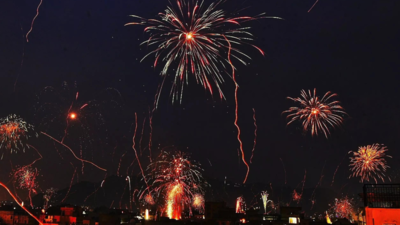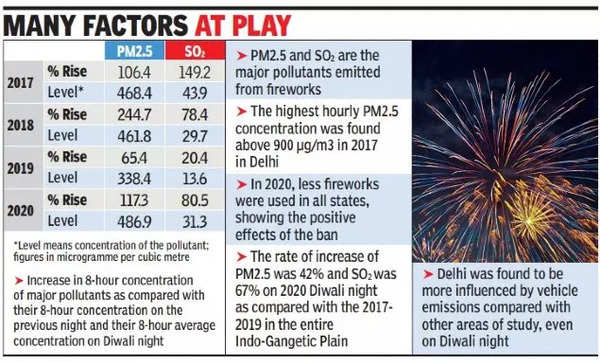Top Searches
- News
- City News
- delhi News
- Why Diwali cracker ban improved air elsewhere, but not in Delhi
Why Diwali cracker ban improved air elsewhere, but not in Delhi

Diwali week for all pollutants in all the states in 2020, except Bihar and West Bengal, the study pointed out. (Representative image)
NEW DELHI: While the ban on fireworks during Diwali did reduce pollution on the entire Indo-Gangetic plain, Delhi wasn’t so lucky. Vehicular emissions and harvest stubble burning in the neighbouring states negated the benefit of the cracker ban and kept pollutant levels high in the city, a study has found.
Researchers at the Postgraduate Institute of Medical Education and Research in Panjab University, Chandigarh, studied the states in the Indo-Gangetic plain, including Delhi, to examine the effectiveness of the fireworks ban on Diwali.

The research team of professor Ravindra Khaiwal, Dr Suman Mor and Sahil Kumar found that the fireworks ban reduced the percentage of PM2.5 and sulphur dioxide on Diwali night dropped by around, respectively, 42% and 67% in 2020 across Indo-Gangetic plain compared with 2017-2019.
However, the air in Delhi was more polluted by vehicle emissions even on Diwali night. Thus, while the lack of firework pollutants dropped, the overall pollution was higher in 2020 than the previous year. The states in the Indo-Gangetic Plain that were studied were Punjab, Haryana, Delhi, Uttar Pradesh, Bihar and West Bengal, considered an air pollution hotspot in south Asia.
“Comparatively, the impact of the firework ban was smaller in Delhi. But simultaneously, crop residue burning was going on in the nearby states and wind movement played a crucial role,” explained Mor, chairman and associate professor, department of environment studies, Panjab university. “Specifically, on Diwali, emission from vehicular movement within the city and influx from the other states was very high, so the overall emissions on Diwali night in Delhi was high.”
The study pointed out that Diwali 2017 was the most polluted in Delhi with regard to all pollutants, while pollutants like oxides of nitrogen and carbon monoxide only showed an excessive increase in 2018 when the farm fire counts reached a high due to stubble burning in Punjab and Haryana.
“Despite the variations, very high background concentrations were recorded for all volatile organic compounds and the maximum was for toluene in all the study years. Delhi, a densely populated mega city, is more influenced by vehicle emissions than other locations, even on Diwali,” the study noted.
Delhi has been implementing a ban on burning firecrackers during Diwali since 2017. “In 2020, all the states of the Indo-Gangetic plain imposed a ban on the storage, sale and burning of firecrackers. The comparison of seven-day pre- and post-Diwali averages showed a significant decrease in the post-Diwali week for all pollutants in all the states in 2020, except Bihar and West Bengal,” the study pointed out.
Researchers at the Postgraduate Institute of Medical Education and Research in Panjab University, Chandigarh, studied the states in the Indo-Gangetic plain, including Delhi, to examine the effectiveness of the fireworks ban on Diwali.

The research team of professor Ravindra Khaiwal, Dr Suman Mor and Sahil Kumar found that the fireworks ban reduced the percentage of PM2.5 and sulphur dioxide on Diwali night dropped by around, respectively, 42% and 67% in 2020 across Indo-Gangetic plain compared with 2017-2019.
However, the air in Delhi was more polluted by vehicle emissions even on Diwali night. Thus, while the lack of firework pollutants dropped, the overall pollution was higher in 2020 than the previous year. The states in the Indo-Gangetic Plain that were studied were Punjab, Haryana, Delhi, Uttar Pradesh, Bihar and West Bengal, considered an air pollution hotspot in south Asia.
“Comparatively, the impact of the firework ban was smaller in Delhi. But simultaneously, crop residue burning was going on in the nearby states and wind movement played a crucial role,” explained Mor, chairman and associate professor, department of environment studies, Panjab university. “Specifically, on Diwali, emission from vehicular movement within the city and influx from the other states was very high, so the overall emissions on Diwali night in Delhi was high.”
The study pointed out that Diwali 2017 was the most polluted in Delhi with regard to all pollutants, while pollutants like oxides of nitrogen and carbon monoxide only showed an excessive increase in 2018 when the farm fire counts reached a high due to stubble burning in Punjab and Haryana.
“Despite the variations, very high background concentrations were recorded for all volatile organic compounds and the maximum was for toluene in all the study years. Delhi, a densely populated mega city, is more influenced by vehicle emissions than other locations, even on Diwali,” the study noted.
Delhi has been implementing a ban on burning firecrackers during Diwali since 2017. “In 2020, all the states of the Indo-Gangetic plain imposed a ban on the storage, sale and burning of firecrackers. The comparison of seven-day pre- and post-Diwali averages showed a significant decrease in the post-Diwali week for all pollutants in all the states in 2020, except Bihar and West Bengal,” the study pointed out.
FOLLOW US ON SOCIAL MEDIA
FacebookTwitterInstagramKOO APPYOUTUBE

Start a Conversation
end of article










